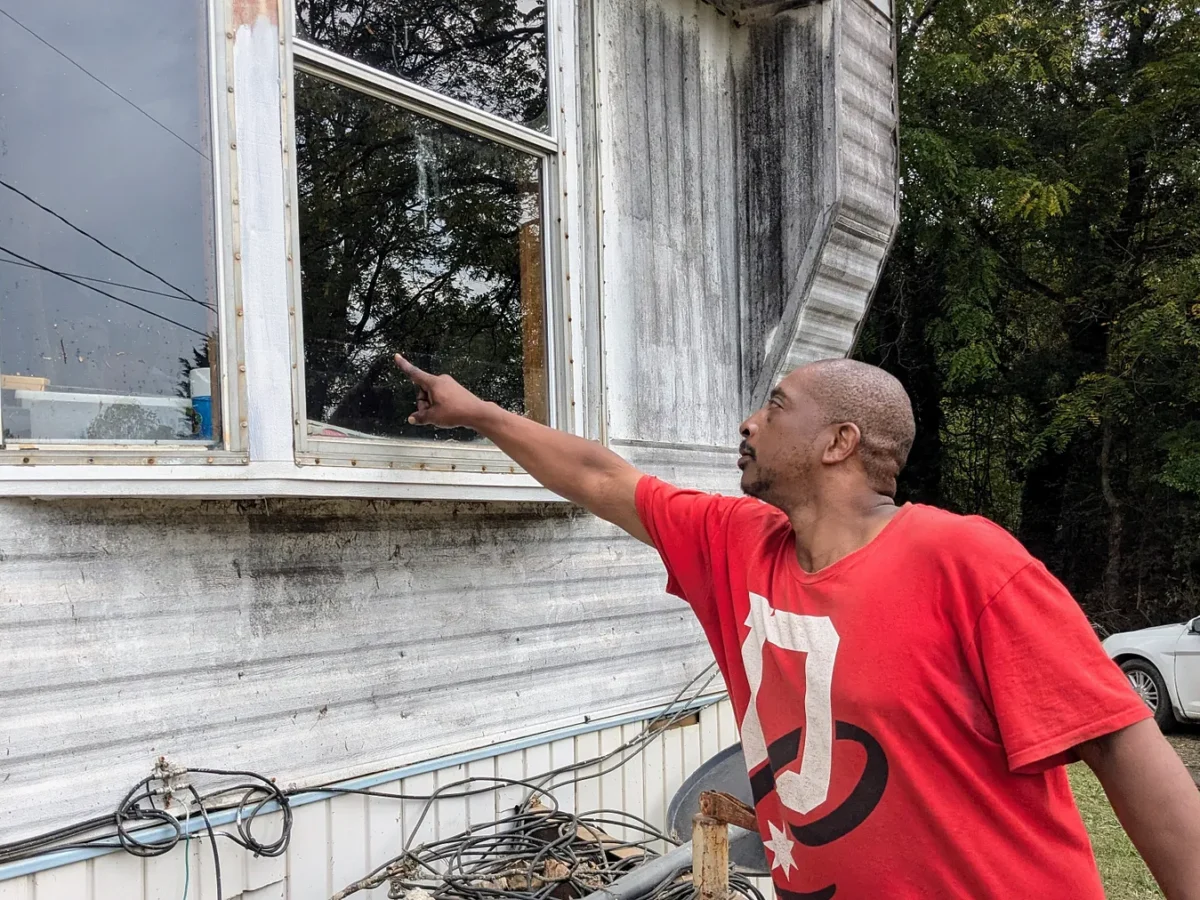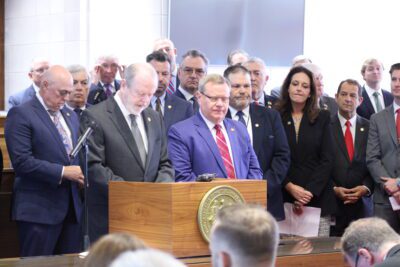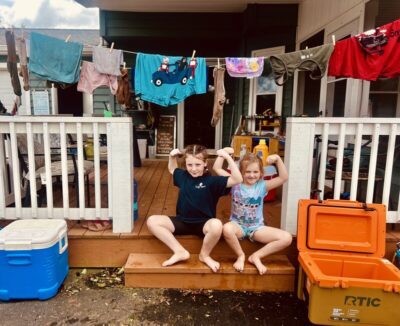
|
|
This story was originally published in the Brevard News Beat.
After leading a tour of the wrecked interior of his mobile home on Cemetery Road, Damon Winstead walked outside to point to the top edge of residue left by last week’s floodwaters.
The deluge from the remnants of 2021’s Tropical Storm Fred — the worst local rainstorm in recent memory — barely crested his front porch, he said.
The flood fueled by Hurricane Helene, on the other hand, destroyed almost all of his possessions and washed the wooden steps from their mooring on the rear of his rented mobile home.
“This was way, way, way higher,” Winstead said Friday.
A few hours earlier, Jeff Ambrose, president-elect of the Cedar Mountain Community Center, grew emotional as he described how residents and business owners came together to create a neighborhood emergency service hub.
They pitched in and provided food donations even though many of their own properties had been flooded, he said.
Val Gerdes, owner of Wood and Vine restaurant and Brevard Pizza Works, left those businesses shuttered to work 13-hour days leading a crew that have been serving about 600 hot meals a day at the Center.
“All I have to do is get the word out that we need something and it shows up,” Ambrose said. “I choke up everytime I think about it.”
The historic severity of the Helene-powered flooding and stirring stories of neighbors helping neighbors: These were the main themes that emerged in the week after the storm roared through Transylvania County, washing out roads, toppling power lines and countless trees, and flooding an unknown number of homes and other buildings.
Throughout the county, residents armed with chain saws or just work gloves formed ad hoc road-clearing crews. Along with churches, nonprofits, businesses and government agencies, they worked to provide shelter, food, water and companionship to residents impacted by Helene.
County Commission Chairman Jason Chappell, at a press briefing on Friday, listed several local companies that had donated services and described conversations with government officials about, for example, the need to quickly repair the washout of US 276 near the Connestee Falls community.
“All our state, local and federal partners have been amazing,” he said.
Chappell, a lifelong county resident, also called Helene “an extraordinary event that is not like anything we’ve ever experienced.”
The storm dumped more rain on Brevard than Fred and more, even, than the epic drenching that led to the collapse of the Lake Toxaway dam in 1916.
And though the county will not have an assessment of the value of the damage or the number of buildings flooded until next week, the devastation seems certain to far outstip any recent rain event.
Helene’s arrival just three years after Fred also fits ominously into a pattern established by climate scientists, who have said global warming is “very likely” to increase the severity and frequency of extreme rain events in Western North Carolina. A study from one climate nonprofit last year singled out Transylvania as especially vulnerable to such storms, predicting that what were once 100-year floods (those with a 1 percent chance of occurring any given year) should be expected to hit the county roughly once a decade.
Which means it is not too soon for the county to think about bolstering its Flood Damage Protection Ordinance, including by raising its minimal requirement that new structures be built one foot above the level reached by 100-year-floods, said Owen Carson, chair of the Transylvania Natural Resources Council.
In the aftermath of Fred, the Council recommended that the county raise this standard, Carson wrote in an email this week, to “allow us better access to flood insurance so we could be better prepared for future events, which are absolutely coming.”
Historic flooding

Owners of flooded homes said Helene was the worst storm they’d seen. So did Mike Owen, the county’s building director and flood administrator — and a lifelong Transylvania resident.
Certainly it’s one of the most severe in the history of both the region and the county, wrote Corey Davis, North Carolina’s assistant state climatologist.
In a blog post published Monday, he explained the causes of the previous week’s epic rains in Western North Carolina, which started days before the arrival of Helene due to a “stalled cold front.”
That “frontal boundary had barely moved” by Thursday, he wrote, when “Helene’s outer rain bands were closing in, adding even more moisture to the mix.”
As runoff began rushing into towns and cities, he added, “the heaviest rain from Helene was just beginning to fall.”
The 18.34 inches measured in Brevard last week eclipsed the previous five-day record of 15.18 inches recorded in the legendary 1916 storm, according to data Davis included in an emailed response to questions from NewsBeat.
The Davidson River crested in Pisgah Forest at just below the previous record from Fred in 2021. And though the five-day rain total recorded in Rosman, 15.96 inches, fell short of the record set during another multi-day deluge in the fall of 1964, the gauge on the French Broad River in the town recorded a water level of 15.55 feet, the highest on record.
Residents monitoring home rain gauges in higher elevations, responding to a Facebook query from NewsBeat, reported even more rainfall over several days last week, including 27.5 inches in Sherwood Forest, 28 inches on Caesar’s Head, and more than 25 inches in “downtown Cedar Mountain.”
The long road to recovery

The impacts were felt by residents such as Nicole Ramirez, who said that Helene’s flooding was the worst she’d experienced in her neighborhood on Cherry Street, off Old Hendersonville Highway.
Ramirez, who has lived in her home for about 10 years, said the previous high water mark, which she believes occurred during Fred, reached halfway up her front yard.
On the Friday of Helene’s arrival, she and her husband, Kyle White, and their nine-year-old daughter, fled their home when the water reached their front porch.
Several inches of water later poured into the main section of their house, while a lower converted garage that serves as rec room and guest quarters was inundated by about three feet, she said.
She and White have since embarked on the long and discouraging process of recovery, she said Thursday. They have ripped up carpet, subflooring and baseboards, depositing piles of debris on their otherwise tidy front yard.
Clothes airing on a railing surrounded Ramirez as she stood on the front porch and described her insurance company’s complex requirements — including documenting losses with photos and spreadsheets of damaged items — for filing a claim.
And though the family has been approved for emergency accommodations by the Federal Emergency Management Agency (FEMA), “every hotel on their list is in South Carolina, Georgia or Tennessee,” said Ramirez, who works at the county’s Department of Social Services.
“There’s no way” she and her husband can move, she said. They need to return to their jobs as soon as possible, she said, “because we have to pay a mortgage on a house we can’t live in.”
She and White have been staying with her parents and her daughter with a sister. In the future they hope to borrow a recreational vehicle so they can all live together near their home, she said.
The helicopters flying overhead as she spoke added to the atmosphere of catastrophe, she said. “Somebody said it’s like living in a war zone.”
But the aircrafts’ presence has also been a comforting reminder that Brevard is on the radar of agencies delivering aid, said White, especially because so much attention has been focused on even harder-hit locations such as Chimney Rock.
“With no communications, you almost feel like you are forgotten,” he said.
The assessment

White and Ramirez have contacted the county building department to conduct a damage assessment, they said, and Owen urged other impacted residents to do the same.
“If water has been inside their homes we need to know about it,” he said.
This will help the county create a complete damage assessment and homeowners secure aid from insurers and FEMA, he said.
And to avoid fire and other potential hazards, he said, assessment is especially critical if water “has gotten over the top of electrical outlets or electrical services.”
At the Friday briefing, County Manager Jaime Laughter listed a wide range of services available from churches and government agencies, information also available on a regularly updated page on the county’s website.
This also includes information on the steady progress utilities including Duke Energy have made in restoring power. As of Friday, the page said, 5,400 Duke customers remained without service, but full restoration is expected early next week.
Laughter said no additional damage from Helene had been found at the county’s public schools and they are due to reopen to students on Oct. 14.
The county will also be able to proceed with the planned sale of bonds for future school repairs as scheduled, she said.
Owen said he and his staff will be working on assessments through the weekend. Among the information they have yet to establish is the number of flooded homes that were built since the 2009 passage of the Flood Ordinance.
That means it is too early to know whether enhanced requirements could have prevented additional damage. But the city of Brevard and several surrounding counties require two feet of so-called “freeboard” above the base flood elevation and the state’s model ordinance recommends four feet of freeboard
The cost of adding an additional foot adds about 1 percent to the cost of new construction, far less than the cost of post-flood repairs, according to the Council’s recommendation, which the County Commission did not adopt.
Though this recommendation did not mention the impact of climate change on extreme rainfall events, Carson, speaking for himself rather than the Council, said he believes it will be dramatic enough to create long-term changes to future development patterns in Transylvania.
“A warming climate . . . is leading to a higher frequency of storms like Helene that boast a higher intensity and sustained duration of precipitation,” he wrote. “I think that in the not-too-distant future, climate change will hem us into the band of land uphill of the 500-year floodplain.”
Coming together

In response to a question about updating the Flood Ordinance, Laughter said that “our focus right now in county government is on meeting the needs of our citizens.”
It has also been the focus of residents and organizations throughout the county. Anchor Baptist Church in Penrose has emerged as a major hub of disaster assistance. On Thursday morning, Mark Hall was one of several volunteers at Rosman Town Hall, handing out water, Meals Ready to Eat and other supplies to residents.
The effort at Cedar Mountain evolved spontaneously, Gerdes said, after her wife, Diane Slover, contacted her cousin, Lucia Gerdes, the owner of the Cedar Mountain Cafe, who was out of the country when the storm hit.
Slover told her they needed to clear food from her flood-damaged restaurant before it spoiled, Val Gerdes said, and Slover began talking about ways to share these supplies rather than destroy them.
The next morning they met with Wendy Caughey, owner of the nearby Creekside Market and Grill, who enthusiastically supported the idea.
“She pulled into our driveway with both guns blazing,” Gerdes said.
Though both the Cedar Mountain Canteen and Cedar Mountain Outpost were flooded, both donated food, Gerdes said.
With a generator provided by Creekside and space at the Center, these supplies were enough to get Gerdes and a volunteer crew started serving meals on Saturday, she said.
Since then donations from residents and government agencies have poured in, and late last week canned goods and boxes of fresh produce crowded tables inside the center and cases of bottled water were stacked shoulder high under an outside awning.
Gerdes has been especially valuable because she has the knowledge to ensure food safety, Ambrose said. She has been arriving at 6 am every morning to start making eggs, bacon, biscuits and gravy, and staying most nights past 7 pm.
The food has been served to residents who were flooded out of their homes, or lost power, or just wanted company in a time of crisis, Ambrose said. Volunteers have provided meals to elderly homebound residents.
The Center has also fed first responders and utility workers and on Saturday was preparing a supply of prime rib from the Cafe that would otherwise go to waste.
“We’re going out with a bang,” Gerdes said.
Couldn’t she be at her own Brevard restaurants, which never lost power and could be up and running?
“Yes,” she said, “but right now I just feel this is more important.”





